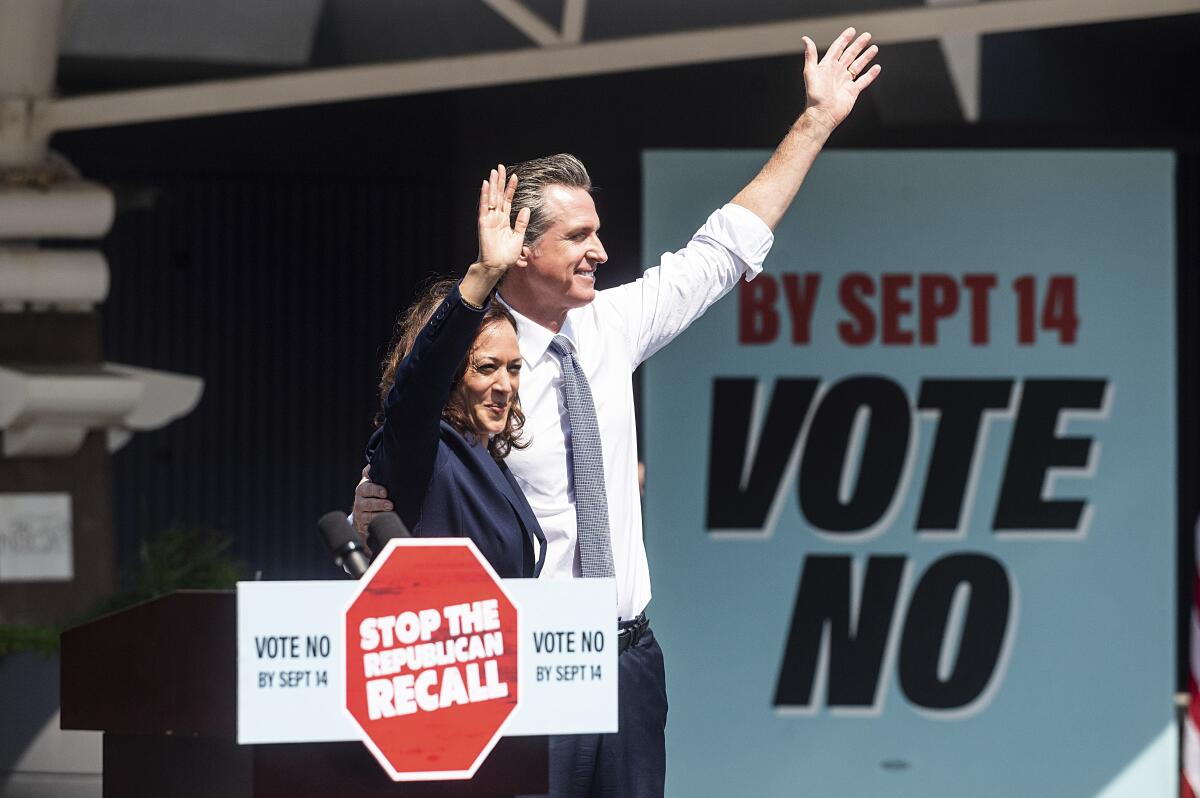Column: If it’s this hard for Newsom, how will Democrats face Trumpism in purple states?

Democrats nationwide face plenty of red flags as they look to next year’s midterm election: their hair-thin majorities in Congress that leave no margin for error, the midterm jinx against a president’s party and now President Biden’s polling slide.
To their relief, polls indicate that California won’t add to the alarms by ousting its Democratic governor for a Trumpian pretender. Even so, Democrats in other states would be wise to take a warning from Gov. Gavin Newsom’s struggle.
If Californians were to recall the governor on Tuesday, the aftershocks for Democrats would reach Washington and shake state capitals in between. They’d be rattled to their core that enough independents and Democrats in the nation’s bluest state would be so restive as to join troublemaking Republicans to boot Newsom and, by extension, reject the progressive Democratic agenda he personifies.
Yet even before party leaders came west to reinforce Newsom’s defense — including Vice President Kamala Harris on Wednesday and President Biden due on Monday — signs pointed to Newsom’s survival.
National Democrats and nonpartisan political pros won’t be all that impressed if Newsom survives. “I don’t think we should over-read into that,” Jessica Taylor, the analyst of governor and Senate races for the nonpartisan Cook Political Report, told me. “This is California, and Democrats are supposed to win.” That Newsom’s victory was ever in doubt is chilling enough.
Still, the recall experience in California holds lessons and cautions for Democrats.
The first is attention to turnout.
Democrats rarely do a good job of getting their voters out in non-presidential elections. Many of their supporters tend to be too busy juggling jobs and family, and less attuned to the news, especially compared to conservatives’ consumption of the red meat of partisan media. Newsom and his party have scrambled to overcome that since early summer, when polls showed a near dead-heat between voters who wanted to remove him from office and those who did not.
That kind of dismal polling was humiliating for Democrats in a state where registered Republicans are less than a quarter of the electorate. And scary. It prompted Democrats to raise many millions more than Republicans for TV, social media and mail advertising to raise awareness of the vote and its stakes.
Paul Mitchell, the vice president at Political Data Inc., this week compared the rate of returned ballots to similar points in other election cycles and — to his shock — found turnout running “in the ballpark” of a presidential election year.
Vulnerable Democrats everywhere shouldn’t wait for scary polling data. They should already know that turnout is a problem to be overcome.
Motivating voters requires more than money for ads. Newsom, and Democrats more broadly, needed a resonant message, a reason for their supporters to vote.
California Republicans have a big one: For years their party has dug itself so deeply into a hole of xenophobia, bigotry, intolerance and science-denial, so out of touch with most residents, that a recall election is just about the only way it can elect a governor. The leader of the motley 46-pack of would-be governors is longtime conservative radio host Larry Elder; a recent poll showed him with 26% support among the Newsom alternatives. That would be enough to win him the governorship if more than 50% of voters decide to recall the governor. Democracy this is not.
Newsom hasn’t been a bad or even unpopular governor, which makes the recall all the more maddening, especially because he’d face the voters next year for reelection. Yet initially his message sounded defensive, reflecting the hydra-headed crises the state faces: homelessness, wildfires, climate change and an ongoing COVID-19 contagion that forced him to make unpopular decisions about business, school and entertainment closures.
Helped by the emergence of Elder, with his history of slams against women, people of color, climate change, vaccine mandates and more, Newsom has made the race less a referendum on his record and more a choice between him and a Trump clone. No one’s helped him more than Elder.
Late last week Elder gloated that as governor he might get to name a Republican to replace 88-year-old Sen. Dianne Feinstein should her seat become vacant — a prospect that would tip the entire Senate to Republicans’ control. You could just hear procrastinating California Democrats rush to their mailboxes to return their ballots.
Similarly, Democrats beyond California have to make the midterm election less a referendum on Biden and their party’s ostensible control of Washington and instead run against the dangers of the Trump Republican Party.
Here, too, Republicans — led by Donald Trump — are helping.
Trump is promoting controversial Senate candidates in several battleground states, like Herschel Walker in Georgia, in defiance of party leaders who doubt those sycophants can win. Texas Republicans’ enactment of an antiabortion state law, with an assist from the Republican-appointed majority on the Supreme Court, has incited women nationwide, especially the educated, suburban voters Republicans used to count on.
“The biggest problem Democrats have is Trump’s not on the ballot,” Taylor, the analyst, said of the midterm.
Like Newsom, Democrats have to convince voters that, in effect, he is.
More to Read
A cure for the common opinion
Get thought-provoking perspectives with our weekly newsletter.
You may occasionally receive promotional content from the Los Angeles Times.











